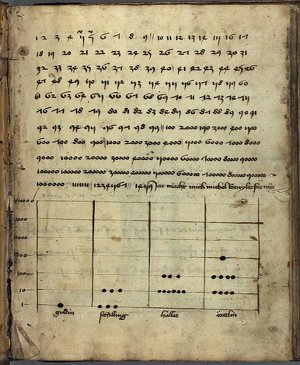Arabic Numbers
Explain how Europe benefited from cultural diffusion during the period c. A.D. 1000 - 1500.

German manuscript dated 1459,
teaching use of Arabic numerals.
The introduction of Arabic numerals into Europe eased arithmetic computations considerably. This system is positional in that the actual value of any numeral is determined by its place in the written number. Thus 2 in 123 stands for twenty, while 2 in 231 has the value two hundred. Nevertheless, the computational rules for addition are independent of position: 2 + 3 always yields 5, whether the digits stand for units or for thousands.
Positional number systems require a symbol for nothing
, hence the introduction of the symbol
zero into European mathematics.
Arabic numerals were neither invented by nor used by the Arabs.
They were developed in India by the Hindus c. 600 A.D. These numbers were
written backwards
, thus one hundred twenty three was written 321.
Around 750 AD, this system of decimal arithmetic was brought to Persia when several important Hindu works were translated into Arabic. In the cultural diffusion of the numeral system to Europe, the method of writing numbers became reversed to the present method.
In c. 875, the noted Arab mathematician al-Khwârizmî wrote a textbook
On the Calculation with Hindu Numerals
.
This book was translated into Latin in the 12th century as Algoritmi de numero Indorum
,
where Algoritmi, the translator's rendition of the author's name, gave rise to the word algorithm
Latin algorithmus, calculation method
).
It is not known exactly when the new number system first came to Europe. The evidence is that
it came many times. The oldest dated European manuscript containing Arabic numbers is the
Codex Vigilanus
written in Spain in 976. Although the French monk and
mathematician Gerbert (940 - 1003), who became Pope Sylvester II in 999, also used them in several of his
writings, they did not yet come into common use.
In 1202, Leonardo of Pisa (also known as Fibonacci), an Italian mathematician who had studied in Bejaia (Bougie), Algeria,
published his Liber Abaci
, a book of
arithmetic and algebraic information. Al-Khwârizmî's book was a major influence on Fibonacci.
Although the book promoted the Arabic numeral system, it was still described as Indian rather than Arabic.
When my father, who had been appointed by his country as public notary in the customs at Bougie acting for the Pisan merchants going there, was in charge, he summoned me to him while I was still a child, and having an eye to usefulness and future convenience, desired me to stay there and receive instruction in the school of accounting. There, when I had been introduced to the art of the Indians' nine symbols through remarkable teaching, knowledge of the art very soon pleased me above all else and I came to understand it.
In spite of the popularity of Fibonacci's book among scholars, the earliest French manuscript to use the new number system was written in 1275. The Greek system of numerals remained popular in regions around the Adriatic for many more years.
In Western Europe, merchants continued to use Roman numerals in keeping their books. However, during the 14th century, Arabic numerals became widely used by merchants in Italy. Due to the trade dominance of the Italian city-states, the new numeral system spread to the rest of Europe.
The European acceptance of Arabic numerals was accelerated by the invention of the printing press, and they became more widespread during the 15th century. By the mid - 16th century, they were in common use in most of Europe. Roman numerals remained in use mostly for the notation of Anno Domini years, and for numbers on clockfaces. Sometimes, Roman numerals are still used for enumeration of lists (as an alternative to alphabetical enumeration), and numbering pages in introductory material in books.
